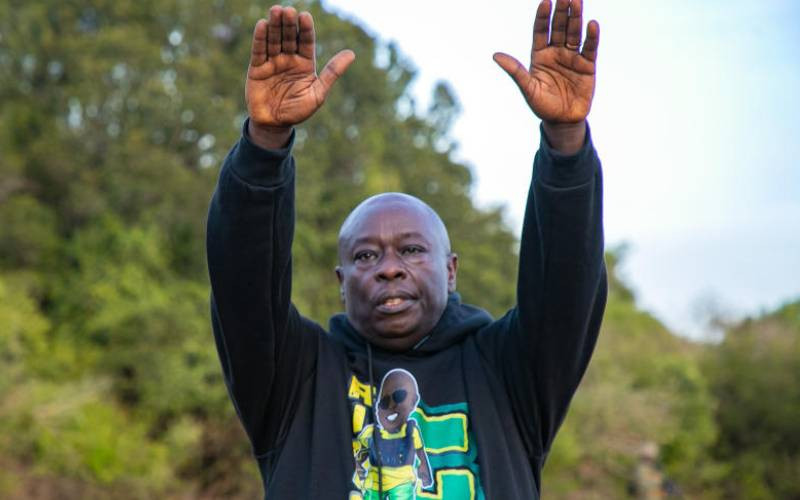 |
|
Kenyan world steeplechase champion Ezekiel Kemboi (left) crosses a finish line. |
By KAMAU MUTUNGA
Kenya is the undisputed champ of the stamina-sapping 3000 metres men’s steeplechase. With 21 cumulative Olympic medals - 10 of them solid gold, no country has ever spiked our ‘Cheps’ in the chase for the past 45 years. It all began with Amos Biwott winning Gold during the 1968 Mexico Olympics. The then 21-year old outsprinted compatriot Benjamin Kogo to silver position after tickling the crowd with the comically rustic jumping of barriers with both feet.
Today, somewhere in Kaptagat or Marigat, a Cherono has just given birth to a Kip-something who, in the fullness of time, will win the steeplechase come rain, hell or high water on the tartan track. Besides the 1976 and 1980 Games that Kenya boycotted over political reasons, at no Olympics has the gold escaped the cusp of Kenya’s patented discipline - the Steeplechase. In fact, the first lithe pair of legs to run the distance in under eight minutes were born in Marakwet, Rift Valley in the name of Moses Kiptanui who clocked 7:59.18 on August 16, 1995 in Zurich, Switzerland. It took nine years for another Kenyan, Stephen Cherono(now Qatari Saaif Saeeed Shaheen) to lower the record by just five seconds at the Van Damme Memorial in Brussels, Belgium in 2004.
Patriarchal Society
Kenyan-American journalist John Manners in Kenya’s Running Tribe notes that between 1987 and 1997, runners from the Rift Valley won “40 per cent of the biggest international honours in men’s distance running” and that record “marks the greatest geographical concentration of achievement in the annals of sport.”
American genetic anthropologist Vincent Sarich statistically estimated, at the time, that an average “Kale” chap can outrun 90 per cent of the rest of the world, while a normal “Kale” lady can outsprint any ordinary man if they are both trained at their full potential.
Funny thing is, our Kalenjin sisters are largely from a patriarchal society. They did not start running actively until the 1990s. Joyce Chepchumba only won Bronze in the marathon in the 2000 Sydney Olympics. But shortly, there was an epidemic of Nancy Lagats, Pamela Jelimos, Janeth Jepkosgeis and Vivian Cheruiyots in the Beijing 2008 and 2012 London Olympics. All from what author Jon Entine called ‘athletic hotspots’ that account for one-fifth of global long-distance medals.
Manners writes that they are born at 5,000 to 10,000 feet above sea level in the highlands where lungs (waiting to exhale in a Diamond League) are long adapted to low-oxygen “making their cardiovascular systems exceptionally strong.”
But there are non-athletic communities living in such altitudes elsewhere in the world. Also disqualify the fish-cake logic about huffing and puffing long-distances to school. Joe Sang in Kenyan Running: Movement Culture, Geography and Global Change, found that 14 out of the world’s 20 international runners hardly ran barefoot to say, Frames of Mind Academy 10 kilometres from home.Could athleticism be heeled via sprinting away from blighting poverty?
Well, experiencing an out-of-money experience in mud-thatched childhood could spur the spike, but not really. Kenyan legends Kipchoge Keino and Amos Biwott excelled when athletes were not in the dough, Golden League speaking.
Manners, who spent decades studying the Kip-somethings guns about their slight body build, ideal for long distance running and being brought up on ‘complex carbohydrate’ rich diets favoured by sports scientists for endurance races. But are there ‘certain Kenyan communities’ whose wiry frames have been motorised by starchy tubers down all the geological ages but whose mahori (lungs) can’t last one steeplechase hurdle.
Running talent
Stellar performance is a combination of optimal capacity for aerobic output, peak oxygen uptake and good running economy which are the forte of the ‘Kale’ athlete who is more potent due to his muscle fibre composition (as the Danish Institute for Sports found out in 2002) as it has more ‘oxidative capacity’ than the competition, wheeling them faster under strenuous, cutthroat conditions of Olympian proportions.
Combined with our athletes strong hearts and lungs, the result is what American long-distance runner Keith Brantly once likened to having a ‘V8 engine in a Volkswagen.’
Let Kip Keino have the last lap as he honours Darwinian genetic selection, nature over nurture and the punishing ‘every-athlete-for-himself’ training: “Most of our runners are naturally born. We have only to work on improvement; the technical part of it….running is in our blood.”
Stay informed. Subscribe to our newsletter
 The Standard Group Plc is a
multi-media organization with investments in media platforms spanning newspaper
print operations, television, radio broadcasting, digital and online services. The
Standard Group is recognized as a leading multi-media house in Kenya with a key
influence in matters of national and international interest.
The Standard Group Plc is a
multi-media organization with investments in media platforms spanning newspaper
print operations, television, radio broadcasting, digital and online services. The
Standard Group is recognized as a leading multi-media house in Kenya with a key
influence in matters of national and international interest.
 The Standard Group Plc is a
multi-media organization with investments in media platforms spanning newspaper
print operations, television, radio broadcasting, digital and online services. The
Standard Group is recognized as a leading multi-media house in Kenya with a key
influence in matters of national and international interest.
The Standard Group Plc is a
multi-media organization with investments in media platforms spanning newspaper
print operations, television, radio broadcasting, digital and online services. The
Standard Group is recognized as a leading multi-media house in Kenya with a key
influence in matters of national and international interest.









